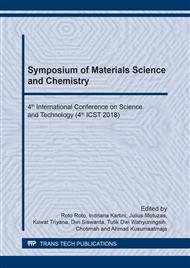[1]
Kementerian Pertanian Republik Indonesia, Statistik Pertanian 2016, Pusat Data dan Informasi Pertanian, Jakarta, (2016).
Google Scholar
[2]
S. Maulina, I. Pandang, Y.P. Ambarita, Comparative study of utilization of oil palm frond to produce oxalic acid by using alkali fusion and oxidation method, Proceeding ICICS, (2015).
Google Scholar
[3]
Ford, M. David, Tella, Achyuta, Huber, George W, Separation of acetic acid from the aqueous fraction of fast pyrolysis bio-oils using nanofiltration and reverse osmosis membranes, Department of Chemical Engineering, University of Massachusetts, (2011).
DOI: 10.1016/j.memsci.2011.05.036
Google Scholar
[4]
J.A. Maga, Smoke in Food Processing, CRC Press, Boca Raton. Florida, (1998).
Google Scholar
[5]
P. Darmadji, H. Triyudiana, Proses pemurnian asap cair dan simulasi kadar benzo(a)pyrene pada proses perendaman ikan, J. Agritech 26 (2006).
Google Scholar
[6]
N. Montazeri, A.C.M. Oliveira, B.H. Himelbloom, M.B. Leigh, C.A. Crapo, Chemical characterization of commercial liquid smoke, J. Food Sci. Nutr. (2013) 112-117.
DOI: 10.1002/fsn3.9
Google Scholar
[7]
J.M. Lingbeck, P. Cordero, C.A. O'Bryan, M.G Johnson, S.C. Ricke, P.G. Crandall, Functionality of liquid smoke as an all-natural antimicrobial in food preservation, J. Meat Sci. 97 (2014) 197-206.
DOI: 10.1016/j.meatsci.2014.02.003
Google Scholar
[8]
R. Schubring, Use of filtered smoke and carbon monoxide with fish, J. Cons. Prot. Food Safety 3 (2008) 31–44.
Google Scholar
[9]
G. Underwood, U.S. Patent 51, (1992).
Google Scholar
[10]
S. Doores, Organic acids. In: P.M. Davidson, A.L. Branen (Eds.), Antimicrobials in Foods. Marcel Dekker, Inc., New York, 1993, p.95–136.
Google Scholar
[11]
M.D. Guillen, M.J. Manzanos, Smoke and liquid smoke. Study of an aqueous smoke flavouring from the aromatic plant Thymus vulgaris L., J. Sci. Food Agric. 79 (1999) 1267–1274.
DOI: 10.1002/(sici)1097-0010(19990715)79:10<1267::aid-jsfa357>3.0.co;2-c
Google Scholar
[12]
K. Kim, T. Kurata, M. Fujimaki, Identification of flavor constituents in carbonyl, non-carbonyl, neutral and basic fractions of aqueous smoke condensates, J. Agric. Biol. Chem. 38 (1974) 53-63.
DOI: 10.1080/00021369.1974.10861117
Google Scholar
[13]
M. Fujimaki, K. Kim, T. Kurata, Analysis and comparison of flavor constituents in aqueous smoke condensates from various woods, J. Agric. Biol. Chem. 38 (1974) 48-52.
DOI: 10.1080/00021369.1974.10861116
Google Scholar
[14]
J. A. Maga, The flavor chemistry of wood smoke, Food Rev. Int. 3 (1987) 139–183.
Google Scholar
[15]
D. Handoko, Yuono, H. Susanto, Experimental study on the effect of coconut shell on tar characteristics, The 22nd Symposium on Chemical Engineering: RSCE, Bangkok, Thailand, (2015).
Google Scholar
[16]
FAO, Smoke Flavourings, Prepared st the 57th JECFA (2001) and published in FNP 52 Add. 9 (2001), 2006 on http://www.fao.org/fileadmin/user_upload/jecfa_additives/docs/Monograph1/Additive-386.pdf.
DOI: 10.4060/ca7513en
Google Scholar
[17]
E.M. Martin, C.A. O'Bryan, R.Y. Lary Jr., C.L. Griffis, K.L.S. Vaughn, J.A. Marcy, S.C. Ricke, P.G. Crandall, Spray application of liquid smoke to reduce or eliminate Listeria monocytogenes surface inoculated on frankfurters, J. Meat Sci. 85 (2010) 640–644.
DOI: 10.1016/j.meatsci.2010.03.017
Google Scholar


